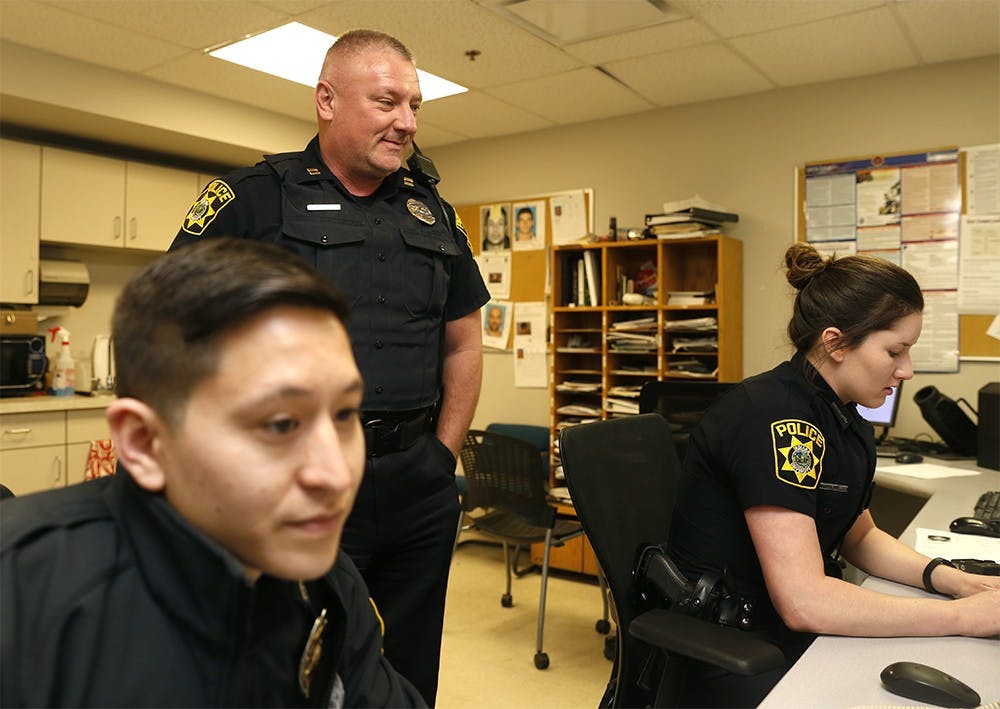Parts 2 and 3 of this series will be published April 12 and 13.
Facing the red Woodburn clock, a campus tour guide last month began his safety spiel. To reassure anxious parents, he described the layers of campus safety measures.
He introduced the various state and local police forces, the Safety Escort program and mentioned city and campus buses as safety features.
“Anything I’m forgetting?” he asked his fellow guide.
“We also have the blue lights,” she said. “But I don’t think they’ve ever been used in an emergency.”
She wasn’t wrong — in the last six months, the IU Police Department responded to seven complaints of suspicious people or vehicles, 88 complaints of harassment or intimidation, 54 assaults, four forcible fondlings and five rapes.
Not once did victims use a blue light emergency phone to report the crimes.
The proper use of a blue light is to hit its red button when in an emergency. This activates a strobe light to draw attention to the area and dials 911 to IUPD.
The University spends between $12,000 and $15,000 annually to maintain the lights. A new light costs about $4,200 to purchase, according to cost estimates from the manufacturer.
“If we get a call from one of those phones, whether or not someone was on the other end talking, we send an officer to check on that,” IUPD Captain Andy Stephenson said. “If you hit that emergency button, it’s a serious thing for us. We treat that as an emergency situation.”
When blue lights are hit, IUPD patrol officers drive to the location, canvas the area and consistently find nothing. This happens almost every day.
In this charade, time is wasted on a campus where four to six officers typically share responsibility for more than 48,000 students. Or, at least, the students who live on campus, because IUPD’s main jurisdiction is bounded by 17th Street, Indiana Avenue, Third Street and the bypass.
In the last 10 years, IUPD has received more than 4,600 calls from blue lights. In the collective memory of veteran IUPD officers, there have only been four legitimate calls from the phones in the past 20 years.
History
The first blue lights were installed by 1989 at a time when the IU Office of Women’s Affairs wanted more safety features on campus. This coincided with a push by Women’s Affairs for more public telephones and more publicity for the Women’s Wheels program, now called Safety Escort.
Almost 15 years later, IU’s student government questioned the usefulness of the blue lights.
On the day the Crimson ticket took office in 2003, executives passed a resolution asking the IU Commission on Personal Safety to perform a detailed study on the maintenance, response time and overall dependability of the blue emergency lights.
The study was never executed, Jonathan Deck, then-IU Student Association safety director, said last month. He said he can’t remember why.
Today, students don’t think about them, even in situations when they could be used.
Just this semester, on the east side of the Student Recreational Sports Center, a male student reported he was approached by a 6-foot-tall black man in the early hours of a February morning.
The man asked the 19-year-old if he had any money and patted him down, according to an IUPD report.
Finding nothing, the man stabbed him in the abdomen and fled, according to the report.
The student ran.
He wasn’t thinking about the cellphone in his pocket. He wasn’t thinking about his surroundings. He wasn’t thinking about much at all, besides getting to safety.
He was not thinking about the blue lights.
Instead, the student arrived at his dorm in the central neighborhood and asked a friend to take him to the hospital.
Lack of knowledge
IU’s enrollment website is inaccurate about the number of phones.
IUPD dispatchers inconsistently log the calls and sometimes file them as 911 calls, not blue light calls, Stephenson said.
Administrators admit to having little knowledge about the blue lights.
There are no evaluations of which phones are most used, only anecdotal evidence, and there have been no formal comparisons by IU of the phone locations to crime maps.
The only people with detailed knowledge of the phones are those who maintain them once a month and the IUPD officers, such as officer Brandon Koppelmann, who deal with them every day.
One night this semester, Koppelmann stood in the squad room at IUPD’s station.
It was almost midnight. He wasn’t quite halfway through his 12-hour patrol shift, but he’d just finished a Monster and needed to stop.
During the break, he chatted with other officers.
“Bet you the one on Sixth and Dunn goes off,” an officer perched on a table said.
The others nodded and chuckled in agreement — it’s common knowledge at IUPD that the blue light located there is pressed most. The speculation is that it’s mostly hit by drunk people walking home from bars as a joke.
“I was working days last week, though, and the one behind Simon biology got hit twice,” the same perched officer said. “Both times, I heard people laughing. Wonder who that was.”
Standard procedure dictates an officer must report to any blue light that is pressed. Most days on the job, officers can sacrifice a few minutes to do this.
Many weekends, officers deal with students binge drinking and drunkenly walking across campus and passing out. They still make time to respond to blue light antics.
However, during Little 500, the danger increases.
As people swarm IU’s campus, dozens of calls come into IUPD dispatch, including ones from blue lights.
One Little 500, while Stephenson was a sergeant, there were just too many calls. He chose to instruct officers that unless someone on the other end of the line actually reports a crime, they should disregard all blue light calls.
That weekend, with a 99.9 percent false-call record, the blue lights were just a distraction.




